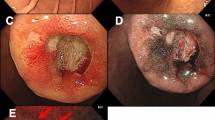Abstract
“Collision tumors” consist of two independent but coexisting tumors. This uncommon situation might be easily mistaken for a composite tumor where one histogenetic event originates from two apparently distinct neoplasms. Colorectal collisions are particularly unusual; here, we report the exceedingly rare case of a 61-year-old man with malignant melanoma and adenocarcinoma colliding in the rectum. Collision tumors have an idiopathic pathophysiology and in fact “accidental meeting” is accepted by many authors. This article discusses the concepts about cancer development, which are overlooked by this hypothesis, another theory to explain that this rare occurrence involves microenvironment changes.



Similar content being viewed by others
References
Pecorella I, Memeo L, Ciardi A, Rotterdam H (2007) An unusual case of colonic mixed adenoendocrine carcinoma: collision versus composite tumor. A case report and review of the literature. Ann Diagn Pathol 11:285–290
Lewin K (1987) Carcinoid tumors and the mixed (composite) glandular-endocrine cell carcinomas. Am J Surg Pathol 11(Suppl 1):71–86
Fenoglio-Preiser CM (1999) Carcinomas and other epithelial and neuroendocrine tumors of the large intestine. In: Fenoglio-Preiser CM (ed) Gastrointestinal pathology. An atlas and text, 2nd edn. Lippincott-Raven, Philadelphia, pp 909–910
Grichnik JM, Burch JA, Schulteis RD et al (2006) Melanoma, a tumor based on a mutant stem cell? J Invest Dermatol 126:142–153
Fang D, Nguyen TK, Leishear K et al (2005) A tumorigenic subpopulation with stem cell properties in melanomas. Cancer Res 65:9328–9337
Milne AN, Carvalho R, van Rees BP, van Lanschot JJ, Offerhaus GJ, Weterman MA (2004) Do collision tumors of the gastroesophageal junction exist? A molecular analysis. Am J Surg Pathol 28:1492–1498
Padmore RF, Lara JF, Ackerman DJ et al (1996) Primary combined malignant melanoma and ductal carcinoma of the breast. A report of two cases. Cancer 78:2515–2525
Wen YH, Giashuddin S, Shapiro RL, Velazquez E, Melamed J (2007) Unusual occurrence of a melanoma with intermixed epithelial component: a true melanocarcinoma?: case report and review of epithelial differentiation in melanoma by light microscopy and immunohistochemistry. Am J Dermatopathol 29:395–399
Nobukawa B, Fujii H, Hirai S et al (1999) Breast carcinoma diverging to aberrant melanocytic differentiation: a case report with histopathologic and loss of heterozygosity analyses. Am J Surg Pathol 23:1280–1287
Habr-Gama A, de Souza PM, Ribeiro U Jr (1998) Low rectal cancer: impact of radiation and chemotherapy on surgical treatment. Dis Colon Rectum 41:1087–1096
Ulich TR, Kollin M, Lewin KJ (1988) Composite gastric carcinoma. Report of a tumor of the carcinomacarcinoid spectrum. Arch Pathol Lab Med 112:91–93
Newton MA, Clipson L, Thliveris AT, Halberg RB (2006) A statistical test of the hypothesis that polyclonal intestinal tumors arise by random collision of initiated clones. Biometrics 62:721–727
Slaughter DP, Southwick HW, Smejkal W (1953) Field cancerization in oral stratified squamous epithelium; clinical implications of multicentric origin. Cancer 6:963–968
Roh YH, Lee HW, Kim MC, Lee KW, Roh MS (2006) Collision tumor of the rectum: a case report of metastatic gastric adenocarcinoma plus primary rectal adenocarcinoma. World J Gastroenterol 12:5569–5572
Eguchi K, Yao T, Konomoto T, Hayashi K, Fujishima M, Tsuneyoshi M (2000) Discordance of p53 mutations of synchronous colorectal carcinomas. Mod Pathol 13:131–139
Piérard GE, Fazaa B, Henry F, Kamoun MR, Piérard-Franchimont C (1997) Collision of primary malignant neoplasms on the skin: the connection between malignant melanoma and basal cell carcinoma. Dermatology 194:378–379
Schwartz L, Balosso J, Baillet F, Brun B, Amman JP, Sasco AJ (2002) Cancer: the role of extracellular disease. Med Hypotheses 58:340–346
Mueller MM, Fusenig NE (2004) Friends or foes–bipolar effects of the tumor stroma in cancer. Nat Rev Cancer 4:839–849
Ishiguro K, Yoshida T, Yagishita H, Numata Y, Okayasu T (2006) Epithelial and stromal genetic instability contribuyes to genesis of colorectal adenomas. Gut 55:695–702
Brandwein-Gensler M, Urken M, Wang B (2004) Collision tumor of the thyroid: a case report of metastatic liposarcoma plus papillary thyroid carcinoma. Head Neck 26:637–641
Bhowmick NA, Neilson EG, Moses HL (2004) Stromal fibroblasts in cancer initiation and progression. Nature 432:332–337
Kalluri R, Zeisberg M (2006) Fibroblast in cancer. Nat Rev Cancer 6:392–401
Orimo A, Grupta PB, Sgroi DC et al (2005) Stromal fibroblasts present in invasive human breast carcinomas promote tumor growth and angiogenesis through elevated SDF-1/CXCL12 secretion. Cell 121:335–348
Schmidt-Hansen B, Klingelhofer J, Grum-Schwensen B et al (2004) Functional significance of metastasis inducing S100A4 (mts1) in tumor-stroma interplay. J Biol Chem 279:24498–24504
Olumi AF, Grossfeld GD, Hayward SW, Carroll PR, Tisty TD, Cunha GR (1999) Carcinoma associated fibroblasts direct tumor progression of initiated human prostatic epithelium. Cancer Res 59:5002–5011
Parrott JA, Nilsson E, Mosher R et al (2001) Stromal-epithelial interactions in the progression of ovarian cancer: influence and source of tumor stromal cells. Mol Cell Endocrinol 175:29–39
Nabili V, Natarajan S, Hirschovitz S, Bhuta S, Abemayor E (2007) Collision tumor of thyroid: metastatic lung adenocarcinoma plus papillary thyroid carcinoma. Am J Otolaryngol 28:218–220
Di Marco A, Baccini P, Pastorino A, Nozza P (1998) Case report of a double ano-rectal neoplasia (adenocarcinoma and melanoma). Pathologica 90:36–41
Delikaris P, Koutmeridis D, Tsonis G, Asimaki A, Mouratidou D (1997) Synchronous anorectal malignant melanoma and rectal adenocarcinoma: report of a case. Dis Colon Rectum 40:105–108
Author information
Authors and Affiliations
Corresponding author
Rights and permissions
About this article
Cite this article
Dias, A.R., Pinto, R.A., Mory, E. et al. Synchronous collision malignant melanoma and adenocarcinoma of the rectum. Tech Coloproctol 14, 181–184 (2010). https://doi.org/10.1007/s10151-010-0571-6
Received:
Accepted:
Published:
Issue Date:
DOI: https://doi.org/10.1007/s10151-010-0571-6




